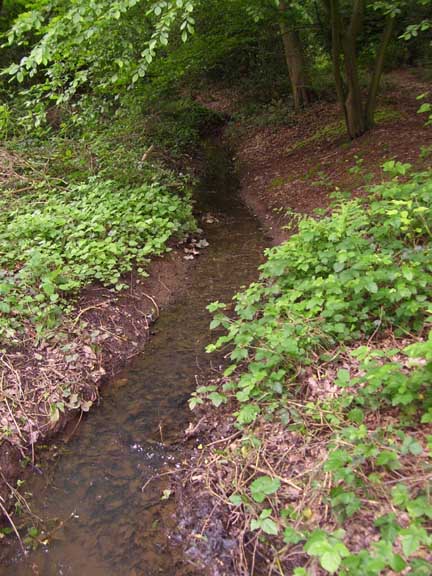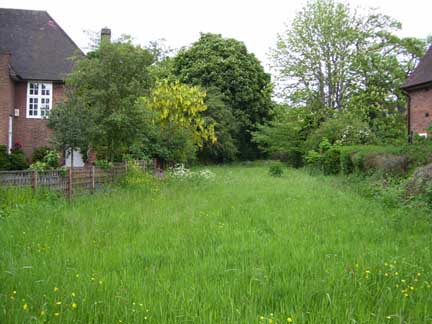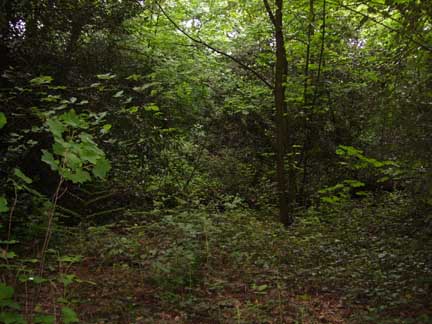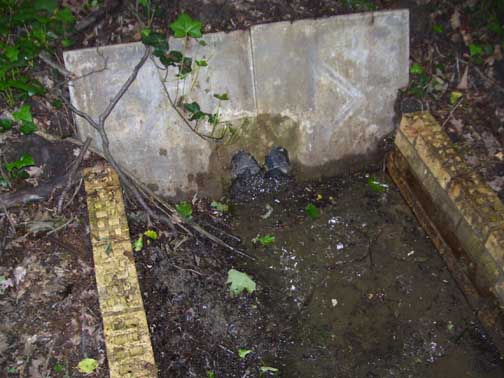On this page we will survey the upper reaches of the Decoy Brook, that “unknown stream” (to use Borough Archivist Hugh Petrie’s phrase) that finds its way into the Brent by Riverside Drive close to the junction of the A406 and Brent Street. The brook takes its name from having formed the south boundary of Decoy Farm, this in turn taking its name from a large duck decoy or lake situated in what is now Brent Park.
The Decoy Brook has wended its course behind the suburban houses of Golders Green. It is visible at points along Wentworth Road as a severe dip behind the houses on the south side. A stretch is clearly visible at the bottom end of Highfield Road. The brook can be more closely examined behind the aforementioned flats at Riverside Drive.  Prior to this Decoy Brook has passed below ground in the back gardens of the houses on the north side of Middleton Road and under the Finchley Road. The relic of the river bed dating from before the stream was piped is traceable to the eye via a glance through the hedge of the Jewish school opposite the end of Middleton Road and as a deep dip in the road surface of Hoop Lane yonder. It is on the Heath extension however that Decoy Brook is most clearly discernable. The brook has two primary sources, each of these issuing from the southern margins of the Heath Extension, running out from below the layer of Claygate sands that once gave the area the name Sandgate at the point where these change to London Clay.
Prior to this Decoy Brook has passed below ground in the back gardens of the houses on the north side of Middleton Road and under the Finchley Road. The relic of the river bed dating from before the stream was piped is traceable to the eye via a glance through the hedge of the Jewish school opposite the end of Middleton Road and as a deep dip in the road surface of Hoop Lane yonder. It is on the Heath extension however that Decoy Brook is most clearly discernable. The brook has two primary sources, each of these issuing from the southern margins of the Heath Extension, running out from below the layer of Claygate sands that once gave the area the name Sandgate at the point where these change to London Clay.
It is on the north edge of Sandy Heath that we first find traces of the brook, a grate close to Wildwood Road showing where the waters will pass through to the Heath Extension. This whole area is bounded up with the political history of the region as the ditches along the heath’s edge here once formed the boundaries of the pre-Norman tracts of Blaeccanham and Hemstedesmearce. The streams seem to be evident as ditches and surface grooves as far south as the ponds in the heart of Sandy Wood.

The waters combine on the Heath Extension
It is with Turners Wood, that peculiar pocket of ancient woodland hidden behind the houses on Ingrams Avenue with which we will now concern ourselves. The wood, named after a Fleet Street tobacconist who once owned the land, is really a kind of dense heartland of waters. A whole complex of little rills surface in the woods and it is extremely difficult trying to track them is such unfamiliar ground. Just getting into the woods is hard enough and I’ve only managed it three times – once with the novelist Will Self and twice with my friend Ian Long. Each time we gained access via a little gated alleyway between the houses to the northeast of the woods, where Ingrams Avenue turns south. This alleyway is situated in direct line with a low-point in Ingram Avenue and the resulting suggestion that a watercourse runs along here is born out once into the wood: the first thing seen is a rill surfacing through a pipe, again in line with the alley and the dip in the road.

The first thing seen is a rill surfacing through a pipe
Another swampy rill runs into the wood from its southeastern corner, this being boosted by a stream issuing from the so-called skating pond located in the grounds of the large house visible through gates at the end of Wild Wood Rise nearby. These three watercourses unite within the wood, forming a rusty bottom slicing through the soft clays, the hornbeam and rhododendron densities. The resulting stream tunnels below Wildwood Road and resurfaces to run along at the base of an old hedgeline cutting across the extension to join the first stream we looked at, the one originating in Sandy Wood.

The stream runs through the heart of Turner''s Wood
To return to this steam, since gaining the Heath Extension it has passed through a string of small ponds – seven in number – the first of which is at least 250 years old. The other ponds apparently date from the 1890s and were dug by unemployed laborers. It is delightful walking along this stretch in early spring when the dried stems of willow herb take on a pink tone in the setting sun and green woodpeckers fly up from the ground, heading to the line of fine oaks along a track close by. Wild service trees, yellow iris and butterbur also make an appearance here.

Once joined the combined Sandy Heath and Turners Wood streams run along the length of the Heath Extension, feeding a small pond near to where the stream turns to the left heading west towards Hampstead Way. From here the stream will run alongside the 42 and 48-inch watermain that forms a green corridor through the suburb. Close by where the watermain backs up to the back-end of the Golders Green crematorium, the waters are diverted to feed the pond in the crematorium grounds. Peering over a wall here, into a garden containing a gypsy caravan yet another small watercourse is visible. After crossing Corringham Road with the watermain our stream passes below Rotherwick Road and behind the houses on the north side of Middleton Road to reach the Finchley Road and the Jewish school written of earlier in this account.

The Decoy runs with the 42 and 48 inch watermain
along a curious green corridor
I visit Turner’s Wood again; and gladly, because villas and fences block my access.
You see I don’t want to enter Turner’s Wood, just stand near its edge and gaze into it. I hope I never enter Turner’s wood. Not because I am afraid of wild animals or mantraps but because the very difficulty of entering it has created a particular relationship that I find fruitful.
There are plenty of woodlands nearby, should I wish to study flora and fauna, trophic layers, the plant associations and communities. A short walk across the heath extension and along the road will bring me to Big Wood and, after, to Little Wood. Besides, the Sandy Heath is just over my shoulder, brooding and powerful on the northern slope of the valley of the Mutton Brook. All these remain accessible to the public but Turner’s Wood is only approachable as far as huge iron gates along Wildwood Rise.
 No. Let me be happy to catch glimpses of Turner’s Wood from the Hampstead Garden Suburb: to peer excitedly at her towering silence through gaps between frozen wealth and human achievement. For Turner’s Wood, so viewed, has become emblematic of a certain mythic property.
No. Let me be happy to catch glimpses of Turner’s Wood from the Hampstead Garden Suburb: to peer excitedly at her towering silence through gaps between frozen wealth and human achievement. For Turner’s Wood, so viewed, has become emblematic of a certain mythic property.
Walking out of Sandy Heath one November afternoon, I see the trees looming over the rooftops of Wildwood road. Large though the houses are along here, some of the older oaks must be twice their height. These are the durmasts of this sandy region, straighter and taller than the more familiar pedunculate oaks. Undergrowth is also visible from points along Ingram Avenue.
And there sits ancient, venerable Turner’s Wood. A pocket of imagined memory backing up against creosoted fences. I asked a man climbing into the jaguar parked in his drive if locals have access. He answered irritably that he didn’t know while his wife looked on scornfully.
“I like your wife” I murmured.
“Sorry?” he snapped.
“It’s OK, I’m only joking” I replied.
On that day, at that time, the sun was setting behind me. The sky over the wood was stained lilac and ochre and the tarmac of these lucrative streets shone with a lilac tint. On Spaniards Close it was blackbird alley. At least three were chuckling away from different points, one hidden deep in a cypress.
And, seemingly timeless, the wood, a fragment of the Great Forest of Middlesex, towering darkly beyond the profits of trade, the emptiness of a Sunday afternoon. A vast flock of ringdoves rose out of the wood and circled high over the Garden Suburb. As the sky began to darken the trees appeared black and remote. Waiting, suggesting an alternative narrative to that which forms our sharp-toothed instrumentality.
I like it like this, this preservation of distance. To see the wood from these angles, contrasting it’s methods with those of our civitas, is to enter a portal leading, if not to the eternal, at least to the possibility, the bare imagining of depth. Of a non-localised consciousness hurtling down time, beyond Channel 4, the Guardian, or page 42 of my 1963 edition of the London A to Z.

The rill originating at the "Skating Pond"
Of course it is illusory. Turner’s Wood is no primeval superorganism waiting to carry me off into its timeless simultaneity. Mapped by satellite, it provides no sanctuary from infrared for the criminal. Though I rise momentarily into the aesthetic object of its form, still I must return to pay bills and fines or to go to the lavatory.
Rooks hang heavy in the trees as I depart. Yew hedges hide the neo-classical porticoes and balustrades of the villas as I glance back at this tangled pubis of the city. Tantalizing and forbidden, Turner’s Wood waits.
Crossing that line now, entering its mystery, would change everything. Once over the threshold it could never be the same between us. Let us remain suspended than, in our continuous deferral. That way I can continue to dream.
|
Turner’s Wood is formed on a spur of the Hampstead ridge extending to the rise upon which the central buildings of the Garden Suburb are located. While the upper edge of Turner’s Wood rests on Bagshot Sands, the bulk of the wood stands on London Clay. However the lower end of the wood is situated on Claygate Beds, which have a high portion of sandy loam. The wood contains large numbers of sessile oaks, Quercus sessiliflora, some rising to about 50ft in height. The pedunculate oak is hardly to be found in the woods. Apparently the hornbeam, Carpinus betulus, subdominated in the past, but whether it is still present I am not sure. Bracken fern, Pteridium aquilinum and bramble, Rubus fruticosus agg, form the shrub layer and subdominate the herbaceous ground flora, leading to a paucity of species. Betony, S. Betonica; Great Woodrush, Luzula maxima; Wood Mellick, Melica uniflora and Millet Grass, Milium effusum are all recorded in Hampstead Heath: its Geology and Natural History, 1913. |

